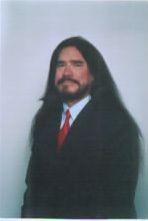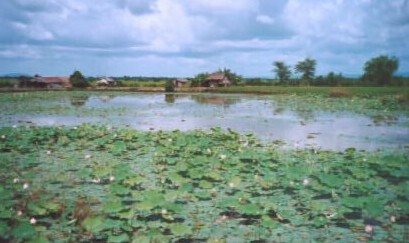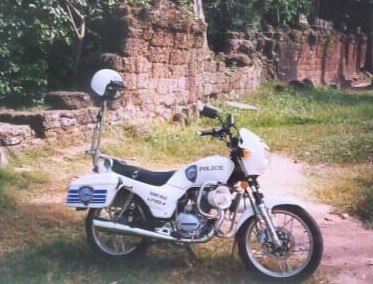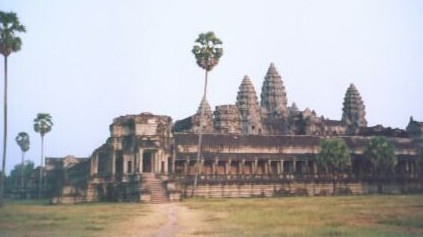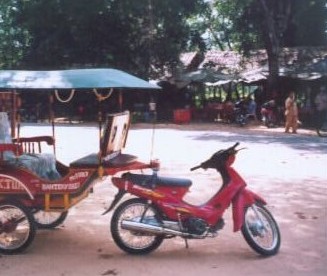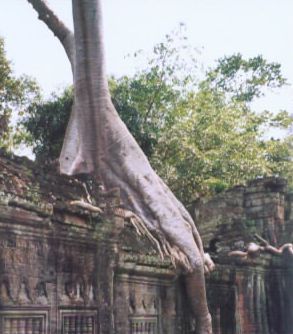|
|
"Danger, it is strongly advised not to attempt to ride a motorcycle here! It's madness. Cambodia is not a good place to get sick or injured. Basic stabilization facilities exist, but for serious treatment, evacuation to Thailand is the only option." That was Cambodia described in the tourist book I had lying on my desk. Looking out the window of my house in Montana I saw a snowflake float past. Snow usually brought a halt to my motorcycle riding. I have had to ride in the stuff from time to time. Some of that riding was memorable but none was fun. In the coming months I knew I would see more of it, possibly a lot more. I also knew I was faced with work and meetings, another set of ugly thoughts. A short walk to my neighbor's house to use his telephone (I do not have one in my Montana cabin) had me booked on a flight to Thailand where I had an apartment reserved and a stored motorcycle.
Sometimes I have to shed my motorcycle riding gear and go into a work mode. The thought of doing this in the coming months, coupled with the snowflakes, found me booked on a flight to Asia for the winter. There I would be riding motorcycles, wearing tee shirts and the only snow I would see would be on TV. My mother says I "clean-up pretty good." I admit to being a two-wheel adrenal gland junkie; a motorcyclist, who thrives on adventure, defined in the true meaning, that being to include the word risk. I do not see adventure as being on a canned motorcycle tour, where the tour guide or organizer has removed all risks. When I see a motorcycle ride with a high degree of risk, like what the Cambodian Tour Book was advising against, I see an opportunity to experience real adventure. Into Cambodia on two wheels I went. Besides an opportunity to suck in an adventure fix, I also saw a chance to mix with one of the Seven Wonders of the World, Angkor Wat.
Palm trees along the road to Siem Riep. Riding by them I could only smile knowing how cold it was in Montana. |
|
|
An idyllic Cambodia village. 85% of Cambodia's people live in villages such as this. With average salaries around $260US per year and 36% of the population classified as poor, Cambodia is one of Asia's poorest countries. A major difference between the people of Thailand and those of Cambodia next door was I heard almost no laughing in Cambodia. The tour book was right, in a sense. To the novice or timid motorcycle pilot, used to rules of the road and pavement, Cambodia would have been a nightmare. The roads were some of the worst I had ridden anywhere on the planet. Often the paved sections were so bombed out it was easier to ride on the dirt shoulders of the road rather than dodging and sometimes not missing the potholes. Several of my motorcycle acquaintances have found the roads to be so bad they opted to pay to load their motorcycles on trucks rather than attempt to ride them to Siem Reip.
The main road into Siem Riep had bombed out sections like this. It was easier to ride on the shoulder than on the pavement. In Phnom Penh, the largest city and capital of Cambodia, the rule of the road was "There are no rules." Small 100-cc motorcycles rode everywhere, dodging trucks and cars, and often on the sidewalks. Stop signs were ignored by all vehicles, and it was not uncommon for several vehicles to use your driving lane, coming at your from the opposite direction. At intersections cars, trucks and motorcycles nosed their way into the intersecting street knowing other vehicles would give way and let them cross. The only place I had ridden motorcycles in the world that might closely approach the madness of Cambodia was India. One local motorcycle shop owner in Phnom Penh suggested the reason for the madness was no one knew there were rules, like a Stop sign meaning Stop. He said anyone that had enough money could purchase a vehicle. There were no requirements that they know how to ride or drive. |
|
|
|||
|
| ||
|
Copyright © Dr. Gregory W. Frazier 1999- All Rights Reserved.
Thoughts and opinions expressed here are those of the author, and not necessarily Horizons Unlimited
|
